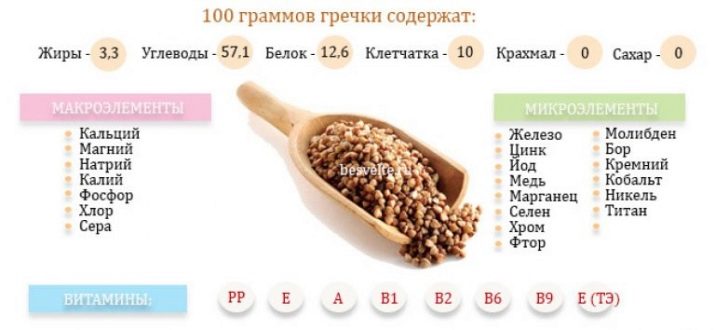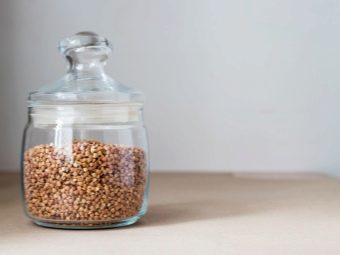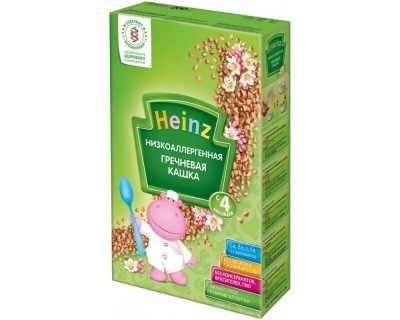Buckwheat porridge for the first food

Complementary feeding is a very important process for the life of the baby and a responsible matter for his parents. A child should gradually get used to adult food, saturate his body with useful elements necessary for healthy growth and development. The body of the baby is not yet accustomed to heavy calorie food, but already needs regular receipt of essential nutrients. This fact serves as a basis for choosing porridge as the first complementary food. Well behaved in such a case beloved by many buckwheat.
Features and benefits of buckwheat
Milk-free buckwheat porridge is selected for the first feeding of the baby according to many factors. It attracts both moms and doctors because:
- does not provoke an allergy due to the absence of gluten in its composition;
- is a nutritious product;
- serves as a source of protein that supplies the body with strength and energy;
- contains a large amount of iron that supports the required amount of hemoglobin;
- includes a lot of calcium needed for normal growth of teeth, bones;
- enriched with iodine, phosphorus, vitamin B, PP, etc., necessary for the proper growth and development of the baby;
- It is perfectly digested by the child’s not yet strengthened body, without provoking constipation.
Buckwheat combines a huge amount of useful qualities. It is suitable for kids, because it is absolutely safe. In this case, buckwheat is well absorbed by the child's body, providing it with all the substances necessary for normal operation.
Such porridge is good not only for its balanced composition. Its value lies in its high nutritional value. Calorie buckwheat is small (110 kcal per 100 g of cereal), but it can saturate the body due to the fiber, proteins and slow carbohydrates it contains.
Thus, buckwheat porridge has several advantages over other children's dishes.
- It contains complex carbohydrates that do not violate blood sugar levels, unlike other types of carbohydrates (simple, fast). Complex carbohydrates are able to maintain a feeling of satiety in the body for a long time, which will contribute to the well-being of the baby. The process of splitting these elements is always accompanied by the process of releasing a huge amount of energy. This will give the child the strength to be active.
- The composition of this cereal contains proteins of plant origin, which are especially appreciated for their easy digestibility, the ability to stimulate the active development of muscle mass. They contain a large number of amino acids, which, when complex compounds are formed, become balanced, and therefore beneficial for the child’s body.
- Buckwheat contains many dietary fibers (fiber), ensuring the correctness of the process of digestion, cleansing the body from harmful substances. For example, buckwheat has three times more fiber than rice.
- It is buckwheat characterized by the absence of gluten. The fact is that buckwheat is a representative of a family of grassy, and not cereal, crops in which gluten is present. This protein can cause an allergic reaction in the baby. Due to the fact that gluten is not gluten, it is a hypoallergenic product. This is another reason for choosing buckwheat porridge for the first feeding.
It is believed that the introduction of buckwheat into the child's food is allowed as early as 4-5 months. However, the process of development of the body in each child takes place individually, so it is worth starting buckwheat food only after consulting with a pediatrician.
How to choose?
For the baby, it is recommended to choose a light-colored croup. This indicator indicates a small temperature processing. In such grains useful microelements and vitamins are stored in larger quantities.
It is best to give preference to jarice - croup consisting of whole grains, but not chopped - croup from battered grain. The kernel is much more useful, because the structure of the grain is not broken.A cutting caused by physical impact loses most of the nutrients. In addition, porridge from such buckwheat flour will be sticky.
It is not recommended to choose buckwheat flakes. Grains for this type of buckwheat are flattened under heavy pressure. This violates the grain structure and leads to the loss of vitamins.
To preserve the benefits of buckwheat, store the grains correctly. To do this, it is recommended to use dry, covered ceramic or glass dishes.
How to cook with your own hands?
Milk-free porridge for the first feeding of a baby under 1 year old is easy to cook by yourself. Homemade porridge will have several advantages over the finished product from the store.
- You will personally choose high-quality grains for the dish, which you will give to your crumbs later.
- You will surely be sure that there will be no undesirable impurities in the porridge (you will cook it yourself).
- Milk porridge of its own production will cost you much less.
It is not recommended to add salt and sugar in baby food. Buckwheat porridge as the first complementary foods is thin, so the first time it is consumed through the nipple. When the baby is ready to eat more dense food, a spoon will be used during feeding. Then the porridge can already do a different consistency.
So, if you want to learn how to cook milk-free porridge for your child, read the following recipes.
Option One
Before cooking buckwheat porridge pre-engage in cereals: select the black grains, all the garbage. Wash the seeds thoroughly and dry them. Using a coffee grinder or blender, grind buckwheat seeds to a flour consistency.
Add water to the grits: 1 tablespoon of buckwheat per 100 ml of water. Bring the mixture to a boil, hold on the fire for 15 minutes. When the porridge has cooled, it should be infused with breast milk or infant formula. How to do it in the right amount, you will be prompted by a pediatrician.
Option Two
Bringing to the boil 300 ml of water, pour 3 tablespoons of selected, well-washed buckwheat. Boil for 30-40 minutes, stirring occasionally. When the cereal is cooked, it will need to be ground well with a blender or rubbed using a sieve. After doing the steps, pour the milk into the porridge (100 ml), bring the mixture to a boil, boil for 5 minutes. The boiled porridge is stirred and allowed to cool.
As you can see, recipes for homemade milk-free porridge are quite simple. At the same time cooked dish brings tremendous benefits.
Products of famous brands and reviews
The advantage of finished porridge from the store is to save time. You only need to open the pack and dilute the already finished product with a liquid of the desired temperature. For mother of a small child, this advantage is very significant. Usually baby food products are checked by the State Audit Office especially carefully, therefore, if there is really little time, there will be nothing terrible if you give a piece of cereal from a pack.
Nestle is one of the most popular companies in the baby food market. Nestle porridges are most popular with parents, because they are easy to prepare (1 tablespoon of the product is poured with 4-5 spoons of breast milk, infant formula or water). Dairy-free Nestle porridges do not contain gluten, that is, as a rule, they do not cause allergies in babies.
Manufacturers assure the absence of preservatives, dyes, flavors. The product of this company is buckwheat groats, containing the necessary vitamins and trace elements, without any impurities. The price of Nestle porridges is higher than the cost of similar products from other brands, but quality has been proven by the presence on the baby food market for more than a decade.
Hainz porridge is in second place in the consumer rating. Based on the reviews of many moms, children sometimes eat this porridge even better than Nestle. The croup in it is milled slightly larger than in the porridge of the first brand. It turns out more lush, airy.However, you should be careful and carefully read the composition. Sometimes the manufacturer adds sugar to his porridge. He does not hide it, honestly pointing out this fact on the packaging.
The milk-free buckwheat porridge "Fruto Nanny" deserves special attention. She likes many mothers because of the appetizing look, light air consistency. The dish is obtained without lumps. The composition of this brand is also pleased with the absence of salt, sugar and any other food additives.
Another brand that I would like to tell about is “Baby”. This porridge is good at its price. This is not an imported brand, but a Russian product. However, the consistency of buckwheat porridge of this manufacturer is slightly worse than that of the first brands. Many mothers complain about the appearance of porridge and the harsh smell of buckwheat. Although, everyone has different tastes. Perhaps your little gourmet will like porridge with a distinctly pronounced buckwheat taste most.
It is important to remember the basic rule - regardless of whether you are feeding the child homemade porridge or food purchased in the store, you need to prepare the dish immediately before feeding. You can not store ready buckwheat in the refrigerator, and then again give it to the baby. Before each feeding porridge is cooked again.
Properly started complementary feeding is a guarantee of healthy nutrition of the child. However, if buckwheat didn’t taste good for your baby, don’t force him to eat the product by force. Perhaps the baby is just not ready for such a lure. Try again after some time.
On how to cook buckwheat porridge for the first feeding, see the following video.































